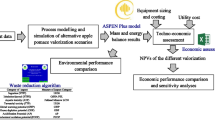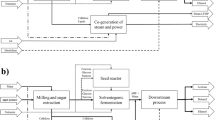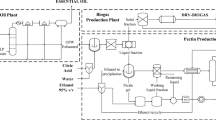Abstract
In line with the prevailing global interest in value extraction from biomass waste streams, the current study explored the technical feasibility of valorizing waste apple pomace (WAP) to produce high-value biochemicals of 5-hydroxymethylfurfural (HMF), lactic acid, and xylitol. Technical feasibility was demonstrated via a process simulation study that employed experimental data and incorporated previously reported approaches in the literature. Economic and environmental performances of the WAP based biorefinery were assessed using the internal rate of return (IRR) and the mass of greenhouse gas emission per unit mass of feedstock (GF) as sufficient performance indicators, respectively. The study was able to show that as the IRR value increased (better economic performance), the GF increased (poorer environmental performance). This suggested that the determination of the optimal condition of the environmental and economic performances would require the imposition of trade-offs. The preferred trade-off condition for enhanced economic and environmental performances was subsequently determined via multi-objective optimization, with a Pareto front containing non-dominated equally optimal solutions subsequently developed. The present work, therefore, provides an in-depth performance analysis of WAP based biorefinery as a waste management strategy. Notably, the proposed strategy of multiple product generation from biomass may be extended to other organic waste based biorefineries.
Graphic Abstract









Similar content being viewed by others
References
Fernando, S., et al.: Biorefineries: current status, challenges, and future direction. Energy Fuels 20(4), 1727–1737 (2006)
Okoro, O.V., Sun, Z., Birch, J.: Meat processing waste as a potential feedstock for biochemicals and biofuels—A review of possible conversion technologies. J. Clean. Prod. 142, 1583–1608 (2017)
Hingsamer, M., Jungmeier, G.: Chapter Five: biorefineries. In: Lago, C., Caldés, N., Lechón, Y. (eds.) The Role of Bioenergy in the Bioeconomy, pp. 179–222. Academic Press, London (2019)
Okoro, O.V., Sun, Z.: The characterisation of biochar and biocrude products of the hydrothermal liquefaction of raw digestate biomass. Biomass Conv. Bioref. (2020). https://doi.org/10.1007/s13399-020-00672-7
Kosseva, M.R.: Chapter 3: Sources, characterization, and composition of food industry wastes. In: Kosseva, M.R., Webb, C. (eds.) Food Industry Wastes, pp. 37–60. Academic Press, San Diego (2013)
Kruczek, M., Drygaś, B., Habryka, C.: Pomace in fruit industry and their contemporary potential application. World Sci. News 48, 259–265 (2016)
Gustafsson, J., et al.: Development of Bio-Based Films and 3D Objects from Apple Pomace. Polymers 11(2), 289 (2019)
Carunchia, M., Wang, L., Han, J.H.: 19: the use of antioxidants in the preservation of snack foods. In: Shahidi, F. (ed.) Handbook of Antioxidants for Food Preservation, pp. 447–474. Woodhead Publishing, Cambridge (2015)
Koen, v.G., Apple production in Belgium from 2005/06 to 2019/2020. 2021, Statista. source. https://www.statista.com/statistics/628823/apple-production-in-belgium/. Accessed 12 Jan 2021
Shalini, R., Gupta, D.K.: Utilization of pomace from apple processing industries: a review. J. Food Sci. Technol. 47(4), 365–371 (2010)
Yates, M., et al.: Multivalorization of apple pomace towards materials and chemicals Waste to wealth. J. Clean Prod. 143, 847–853 (2017)
Bhushan, S., Gupta, M.: Apple pomace: source of dietary fibre and antioxidant for food fortification. In: Preedy, V.R., Srirajaskanthan, R., Patel, V.B. (eds.) Handbook of Food Fortification and Health: From Concepts to Public Health Applications, vol. 2, pp. 21–27. Springer, New York (2013)
Lyu, F., et al.: Apple Pomace as a functional and healthy ingredient in food products: a review. Processes 8(3), 319 (2020)
Antonic, B., et al.: Apple pomace as food fortification ingredient: a systematic review and meta-analysis. J. Food Sci. 85(10), 2977–2985 (2020)
Abdel-Rahman, M.A., Tashiro, Y., Sonomoto, K.: Recent advances in lactic acid production by microbial fermentation processes. Biotechnol. Adv. 31(6), 877–902 (2013)
Dusselier, M., et al.: Toward functional polyester building blocks from renewable glycolaldehyde with Sn cascade catalysis. ACS Catal. 3(8), 1786–1800 (2013)
Dagher, S.F., et al.: Chapter 5: cell immobilization for production of lactic acid: biofilms do it naturally. In: Advances in Applied Microbiology, pp. 113–148. Academic Press (2010)
E4tech, UK Top Bio-based Chemicals Opportunitie. London, E4tech (2017)
BusinessWire, Global Lactic Acid Market 2017–2025 - Growth Trends, Key Players, Competitive Strategies and Forecasts - Research and Markets (2017). [online] Available: https://www.businesswire.com/news/home/20170621005594/en/Global-Lactic-Acid-Market-2017-2025---Growth-Trends-Key-Players-Competitive-Strategies-and-Forecasts---Research-and-Markets. Accessed 20 Feb 2021.
Azaizeh, H., et al.: Production of lactic Acid FROM carob, banana and sugarcane lignocellulose biomass. Molecules 25(13), 2956 (2020)
Román-Leshkov, Y., Chheda, J.N., Dumesic, J.A.: Phase modifiers promote efficient production of hydroxymethylfurfural from fructose. Science 312(5782), 1933–1937 (2006)
Zhou, C., et al.: Conversion of glucose into 5-hydroxymethylfurfural in different solvents and catalysts: reaction kinetics and mechanism. Egypt. J. Pet. 26(2), 477–487 (2017)
Motagamwala, A.H., et al.: Toward biomass-derived renewable plastics: Production of 2, 5-furandicarboxylic acid from fructose. Sci. Adv. (2018). https://doi.org/10.1126/sciadv.aap9722
Delgado Arcaño, Y., et al.: Xylitol: a review on the progress and challenges of its production by chemical route. Catal. Today 344, 2–14 (2020)
Venkateswar Rao, L., et al.: Bioconversion of lignocellulosic biomass to xylitol: An overview. Bioresour. Technol. 213, 299–310 (2016)
Industryexperts.: Xylitol – A Global Market Overview (2017). [online] Available: https://industry-experts.com/verticals/food-and-beverage/xylitol-a-global-market-overview. Accessed 20 Dec 2020
Werpy, T., Petersen, G., Aden, A., Bozell, J., Holladay, J., White, J., Manheim, A., Elliot, D., Lasure, L., Jones, S.: Results of screening for potential candidates from sugars and synthesis gas. Top Value Added Chem. Biomass. 1, 76 (2004)
Alnur, A., Sakinah, M., Mustafa, A.B., Kamarudin, H., Norazian, M.N.: Simulation of xylitol production: a review. Austr. J. Basic Appl. Sci. 7(5), 366–372 (2013)
Schefflan, R.: Teach Yourself the Basics of Aspen Plus. Wiley Online Library (2011)
Okoro, O.V., Sun, Z., Birch, J.: Techno-economic assessment of a scaled-up meat waste biorefinery system: a simulation study. Materials 12(7), 1030 (2019)
Marcotullio, G.: The chemistry and technology of furfural production in modern lignocellulose-feedstock biorefineries. (2011). Delft. TU Delft [online]. Available: http://resolver.tudelft.nl/uuid:a307ecb3-513a-4f57-b519-873a73403cfd. Accessed 23 Jan 2021.
Peña-Tejedor, S., et al.: Vapor–liquid equilibria and excess volumes of the binary systems ethanol+ ethyl lactate, isopropanol+ isopropyl lactate and n-butanol+ n-butyl lactate at 101.325 kPa. Fluid Ph. Equilib. (2005). https://doi.org/10.1016/j.fluid.2005.02.015
Deterre, S., et al.: Vapor–liquid equilibria measurements of bitter orange aroma compounds highly diluted in boiling hydro-alcoholic solutions at 101.3 kPa. J. Chem. Eng. Data (2012). https://doi.org/10.1021/je3004854
Vu, D.T., et al.: Vapor−liquid equilibria in the systems ethyl lactate+ ethanol and ethyl lactate+ water. J. Chem. Eng. Data 51(4), 1220–1225 (2006)
Petersen, A.M., et al.: Evaluating refinery configurations for deriving sustainable aviation fuel from ethanol or syncrude. Fuel Process. Technol. 219, 106879 (2021)
ASPEN-plus, Aspen Plus User Guide. 2000, ASPEN technology incorporated: Cambridge.
Alibaba.: Mechanical Dewatering device (2021). Available: https://www.alibaba.com/product-detail/Dewatering-Dewatering-Machine-NORSEN-Vehicular-Sludge_1600051333912.html?spm=a2700.galleryofferlist.normal_offer.d_title.5c49383dKmOCni&s=p. Accessed 12 Feb 2021
Zimmer, E., Optimal use of resources and energy during fruit juice extraction. 2017, Fruit Processing: Nlederwenlngen.
Okoro, O.V., Shavandi, A.: An assessment of the utilization of waste apple slurry in bio-succinic acid and bioenergy production. Int. J. Environ. Sci. Technol. (2021). https://doi.org/10.1007/s13762-021-03235-z
Kim, D.: Physico-chemical conversion of lignocellulose: inhibitor effects and detoxification strategies: a mini review. Molecules (2018). https://doi.org/10.3390/molecules23020309
Pérez, J.A., et al.: Optimizing liquid hot water pretreatment conditions to enhance sugar recovery from wheat straw for fuel-ethanol production. Fuel 87(17), 3640–3647 (2008)
Hijosa-Valsero, M., Paniagua-García, A.I., Díez-Antolínez, R.: Biobutanol production from apple pomace: the importance of pretreatment methods on the fermentability of lignocellulosic agro-food wastes. Appl. Microbiol. Biotechnol. 101(21), 8041–8052 (2017)
Iyer, P.V., Thomas, S., Lee Y.Y.: High-yield fermentation of pentoses into lactic acid. In: Finkelstein M., Davison B.H. (eds) Twenty-First Symposium on Biotechnology for Fuels and Chemicals. Applied Biochemistry and Biotechnology. Humana Press, Totowa, NJ (2000). https://doi.org/10.1007/978-1-4612-1392-5_51
Su, C.-Y., et al.: Control of highly interconnected reactive distillation processes: purification of raw lactic acid by esterification and hydrolysis. Ind. Eng. Chem. Res. 54(27), 6932–6940 (2015)
Kamble, S.P., et al.: Purification of lactic acid via esterification of lactic acid using a packed column, followed by hydrolysis of methyl lactate using three continuously stirred tank reactors (cstrs) in series: a continuous pilot plant study. Ind. Eng. Chem. Res. 51(4), 1506–1514 (2012)
Lee, H., Development of lactic and succinic acid biorefinery configurations for integration into a thermomechanical pulp mill. 2015, École Polytechnique de Montréal.
Kumar, R., Nanavati, H., Noronha, S.B., Mahajani, S.M.: A continuous process for the recovery of lactic acid by reactive distillation. J. Chem. Technol. Biotechnol. 81(11), 1767–1777 (2006)
Melaja, A., Hämäläinen, L.: US-patent, 4,008,285: Process for making xylitol. p. 285 (1977)
Mountraki, A.D., Koutsospyros, K.R., Mlayah, B.B., Kokossis, A.C.: Selection of biorefinery routes: the case of xylitol and its integration with an organosolv process. Waste Biomass Valor. 8(7), 2283–2300 (2017)
Mikkola, J.P., Salmi, T., Sjöholm, R.: Modelling of kinetics and mass transfer in the hydrogenation of xylose over Raney nickel catalyst. J. Chem. Technol. Biotechnol. 74(7), 655–662 (1999)
Martínez, E.A., Giulietti, M., Almeida, J.B., Derenzo, S., Almeida Felipe, M.D.: Batch cooling crystallization of xylitol produced by biotechnological route. J. Chem. Technol. Biotechnol. 4(3), 376–381 (2009)
Wang, Z., et al.: Measurement and correlation of solubility of xylitol in binary water+ethanol solvent mixtures between 278.00 K and 323.00K. Korean J. Chem. Eng. 30(4), 931–936 (2013)
Kougioumtzis, M.A., Marianou, A., Atsonios, K., Michailof, C., Nikolopoulos, N., Koukouzas, N., Kakaras, E.: Production of 5-HMF from cellulosic biomass: Experimental results and integrated process simulation. Waste Biomass Valor. 9(12), 2433–2445 (2018)
Santiago, B.S., Guirardello, R.: 5-hydroxymethylfurfural production in a lignocellulosic biorefinery: techno-economic analysis. Chem. Eng. Transact. 80, 139–144 (2020)
Petersen, A.M., et al.: Evaluation of biorefining scenarios for advanced fuels production from triticale grain. Energy Fuels 34(9), 11003–11013 (2020)
Okoro, O.V., Sun, Z., Birch, J.: Catalyst-free biodiesel production methods: a comparative technical and environmental evaluation. Sustainability 10(1), 127 (2018)
Okoro, O.V., Faloye, F.D.: Comparative assessment of thermo-syngas fermentative and liquefaction technologies as waste plastics repurposing strategies. AgriEngineering 2(3), 378–392 (2020)
Okoro, O.V., Banson, A.N., Zhang, H.: Circumventing unintended impacts of waste N95 facemask generated during the COVID-19 pandemic: a conceptual design approach. ChemEngineering 4(3), 54 (2020)
Kumar, D., Long, S.P., Singh, V.: Biorefinery for combined production of jet fuel and ethanol from lipid-producing sugarcane: a techno-economic evaluation. Gcb Bioenergy 10(2), 92–107 (2018)
García Haro, P.: Thermochemical Biorefineries and based on DME as platform chemical: conceptual design and technoeconomic assessment. Biorrefinerías Termoquímicas basadas en DME como intermediario: Diseño conceptual y análisis tecno-económico. 2013. Univesity of Sevilla, Spain
Towler, G., Sinnott, R.: Chemical Engineering Design: Principles, Practice and Economics of Plant and Process Design. Elsevier, Amsterdam (2008)
Lange, J.P.: Fuels and chemicals manufacturing; guidelines for understanding and minimizing the production costs. CATTECH 5, 82–95 (2001). https://doi.org/10.1023/A:1011944622328
Christensen, P., et al.: Cost Estimate Classification system-as applied in engineering, procurement, and construction for the process industries (2005). [Online]. Available: https://www.costengineering.eu/Downloads/articles/AACE_CLASSIFICATION_SYSTEM.pdf. Accessed 1 Feb 2021
Chemical-Engineering, CEPCI (2021) [Online]. Available: https://www.chemengonline.com/tag/cepci/. Accessed 2 Feb 2021
Spath, P., et al., Biomass to hydrogen production detailed design and economics utilizing the Battelle Columbus Laboratory indirectly-heated gasifier. 2005, National Renewable Energy Lab., Golden, CO (US).
Doka G.: Life Cycle Inventories of Waste Treatment Services. ecoinvent report No. 13. Swiss Centre for Life Cycle Inventories, Dübendorf (2003)
Hedemann J., König U.: Technical Documentation of the ecoinvent Database. Final report ecoinvent data v2.0, No. 4. Swiss Centre for Life Cycle Inventories. Dübendorf, CH (2007)
Forest-research: Carbon emissions of different fuels (2021). [Online]. Available: https://www.forestresearch.gov.uk/tools-and-resources/biomass-energy-resources/reference-biomass/facts-figures/carbon-emissions-of-different-fuels/. Accessed 23 Feb 2021
CES-MED: Technical Annex to the SEAP template instructions document: The Emission Factors. Cleaner energy saving Mediterranean cities [Online] (2015). Available: https://www.ces-med.eu/publications/technical-annex-seap. Accessed 9 Feb 2021
Rangaiah, G.P., Feng, Z., Hoadley, A.F.J.P.: Multi-objective optimization applications in chemical process engineering: tutorial and review. Process. 8(5), 508 (2020)
Srinivas, N., Deb, K.: Muiltiobjective optimization using nondominated sorting in genetic algorithms. Evol. Comput. 2(3), 221–248 (1994)
Chaudhari, P., Gupta, S.K.: Multiobjective optimization of a fixed bed maleic anhydride reactor using an improved biomimetic adaptation of NSGA-II. Ind. Eng. Chem. Res. 51(8), 3279–3294 (2012)
Deb K., Agrawal S., Pratap A., Meyarivan T.: A fast elitist non-dominated sorting genetic algorithm for multi-objective optimization: NSGA-II. In: Schoenauer M. et al. (eds) Parallel Problem Solving from Nature PPSN VI. PPSN 2000. Lecture Notes in Computer Science, vol 1917. Springer, Berlin, Heidelberg (2000). https://doi.org/10.1007/3-540-45356-3_83
Deb, K.: Multi-objective optimisation using evolutionary algorithms: an introduction. In: Multi-Objective Evolutionary Optimisation for Product Design and Manufacturing, pp. 3–34. Springer (2011)
SolverXL: SolveXL - Genetic Algorithm Optimization add-in for Microsoft Excel. [Online] (2013). Available: https://www.solvexl.com/. Accessed 10 Feb 2021
Gassara, F., et al.: Pomace waste management scenarios in Québec—impact on greenhouse gas emissions. J. Hazard. Mater. 192(3), 1178–1185 (2011)
Acknowledgements
The first author gratefully acknowledges the financial support of Wallonia-Brussels International via the Wallonie-Bruxelles International (WBI) excellence Postdoctoral fellowship. Materne company is also acknowledged for their expert information input.
Funding
This research received no external funding.
Author information
Authors and Affiliations
Corresponding authors
Ethics declarations
Conflict of interest
The authors declare no conflict of interest in this study.
Additional information
Publisher's Note
Springer Nature remains neutral with regard to jurisdictional claims in published maps and institutional affiliations.
Supplementary Information
Below is the link to the electronic supplementary material.
Rights and permissions
About this article
Cite this article
Okoro, O.V., Nie, L., Hobbi, P. et al. Valorization of Waste Apple Pomace for Production of Platform Biochemicals: A Multi-Objective Optimization Study. Waste Biomass Valor 12, 6887–6901 (2021). https://doi.org/10.1007/s12649-021-01487-x
Received:
Accepted:
Published:
Issue Date:
DOI: https://doi.org/10.1007/s12649-021-01487-x




